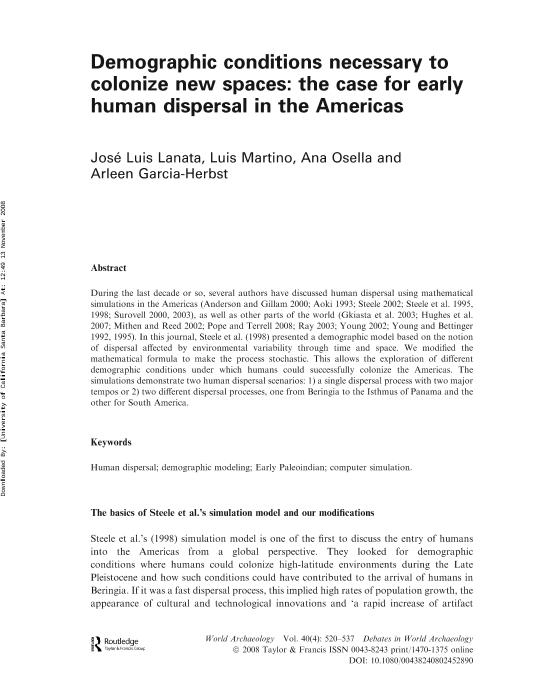Artículo
Demographic conditions necessary to colonize new spaces: the case for early human dispersal in the Americas
Fecha de publicación:
03/11/2008
Editorial:
Taylor & Francis
Revista:
World Archaeology
ISSN:
0043-8243
e-ISSN:
1470-1375
Idioma:
Inglés
Tipo de recurso:
Artículo publicado
Clasificación temática:
Resumen
During the last decade or so, several authors have discussed human dispersal using mathematical simulations in the Americas (Anderson and Gillam 2000; Aoki 1993; Steele 2002; Steele et al. 1995, 1998; Surovell 2000, 2003), as well as other parts of the world (Gkiasta et al. 2003; Hughes et al. 2007; Mithen and Reed 2002; Pope and Terrell 2008; Ray 2003; Young 2002; Young and Bettinger 1992, 1995). In this journal, Steele et al. (1998) presented a demographic model based on the notion of dispersal affected by environmental variability through time and space. We modified the mathematical formula to make the process stochastic. This allows the exploration of different demographic conditions under which humans could successfully colonize the Americas. The simulations demonstrate two human dispersal scenarios: 1) a single dispersal process with two major tempos or 2) two different dispersal processes, one from Beringia to the Isthmus of Panama and the other for South America.
Archivos asociados
Licencia
Identificadores
Colecciones
Articulos(IIDYPCA)
Articulos de INST. DE INVESTIGACIONES EN DIVERSIDAD CULTURAL Y PROCESOS DE CAMBIO
Articulos de INST. DE INVESTIGACIONES EN DIVERSIDAD CULTURAL Y PROCESOS DE CAMBIO
Citación
Lanata, Jose Luis; Martino, Luis Angel; Osella, Ana; Garcia Herbst, Arleen; Demographic conditions necessary to colonize new spaces: the case for early human dispersal in the Americas; Taylor & Francis; World Archaeology; 40; 4; 3-11-2008; 520-537
Compartir
Altmétricas




